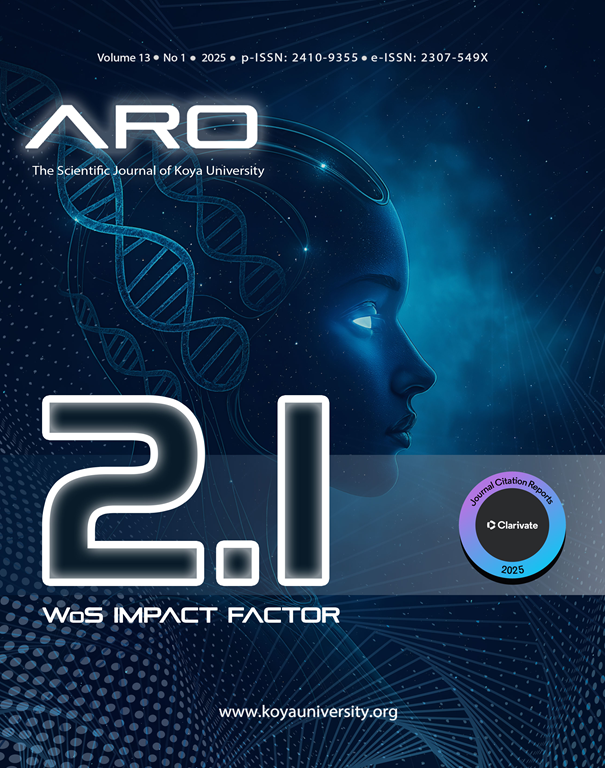Hybrid Cryptosystem with Computational Ghost Imaging Based on Integer Wavelet Transform and Chaotic Maps
DOI:
https://doi.org/10.14500/aro.12153Keywords:
Chaotic maps, Cryptography, Ghost imaging, Optical image encryption, Wavelet transformAbstract
Computational ghost imaging encryption (CGIE) has gained increasing attention from researchers in the field of optical cryptography due to its unique phenomenon. However, traditional CGIE suffers from long imaging time, inherent system linearity, and an enormous number of random phase masks that must be transmitted as secret keys, which limits its application in practical communication. In this paper, a hybrid optical image encryption approach is proposed using CGIE based on integer wavelet transform and chaotic maps. In addition, Hadamard basis patterns are employed to reduce sampling times and improve reconstructed image quality. Simulation results demonstrate that the proposed system is robust against different types of attacks with high key sensitivity and low execution times of 0.03 s for encryption and 0.14 s for decryption. This approach will ensure broader adoption of this technology by facilitating its integration into cryptosystems.
Downloads
References
Alghamdi, Y., Munir, A., and Ahmad, J., 2022. A lightweight image encryption algorithm based on chaotic map and random substitution. Entropy, 24(10), p. 1344. DOI: https://doi.org/10.3390/e24101344
Ananthi, A., Subathra, M.S., Thomas George, S., and Sairamya, N.J., 2024. Entropy-based feature extraction for classification of EEG signal using lifting wavelet transform. Przeglad Elektrotechniczny, 9, pp. 146-150. DOI: https://doi.org/10.15199/48.2024.09.27
Arroyo, D., Alvarez, G., Li, S.J., Li, C.Q., and Fernandez, V., 2009. Cryptanalysis of a new chaotic cryptosystem based on ergodicity. International Journal of Modern Physics B, 23, pp. 651-659. DOI: https://doi.org/10.1142/S0217979209049966
Chen, W., and Chen, X., 2015. Ghost imaging using labyrinth-like phase modulation patterns for high-efficiency and high-security optical encryption. Europhysics Letters, 109(1), p. 14001. DOI: https://doi.org/10.1209/0295-5075/109/14001
Chen, Y., Tang, C., and Yi, Z., 2020. A novel image encryption scheme based on PWLCM and standard map. Complexity, 23, p. 3026972. DOI: https://doi.org/10.1155/2020/3026972
Chowdhary, C.L., Virenbhai Patel, P., Kathrotia, K.J., Attique, M., Perumal, K., and Ijaz, M.F., 2020. Analytical study of hybrid techniques for image encryption and decryption. Sensors, 20(18), p. 5162. DOI: https://doi.org/10.3390/s20185162
Clemente, P., Durán, V., Torres-Company, V., Tajahuerce, E., and Lancis, J., 2010. Optical encryption based on computational ghost imaging. Optics Letters, 35, pp. 2391-2393. DOI: https://doi.org/10.1364/OL.35.002391
Dick, B., 2014. Inverting ion images without Abel inversion: Maximum entropy reconstruction of velocity maps. Physical Chemistry Chemical Physics, 16(2), pp. 570-580. DOI: https://doi.org/10.1039/C3CP53673D
Duran, V., 2011. Optical encryption with compressive ghost imaging. In: The European Conference on Lasers and Electro-Optics. Optica, United States, p. CH3-4.
Elashry, I.F., Farag Allah, O.S., Abbas, A.M., El-Rabaie, S., and Abd El-Samie, F.E., 2009. Homomorphic image encryption. Journal of Electronic Imaging, 18(3), p. 033002. DOI: https://doi.org/10.1117/1.3167847
Guo, Z., Chen, S.H., Zhou, L., and Gong, L.H., 2024. Optical image encryption and authentication scheme with computational ghost imaging. Applied Mathematical Modelling, 131, pp. 49-66. DOI: https://doi.org/10.1016/j.apm.2024.04.012
Huang, H., and Han, Z., 2024. Computational ghost imaging encryption using RSA algorithm and discrete wavelet transform. Results in Physics, 56, p. 107282. DOI: https://doi.org/10.1016/j.rinp.2023.107282
İnce, C., İnce, K., and Hanbay, D., 2024. Novel image pixel scrambling technique for efficient color image encryption in resource-constrained iot devices. Multimedia Tools and Applications, 83(29), pp. 72789-72817. DOI: https://doi.org/10.1007/s11042-024-18620-2
Jiang, S., Wang, Y., Long, T., Meng, X., Yang, X., Shu, R., and Sun, B., 2017. Information security scheme based on computational temporal ghost imaging. Scientific Reports, 7(1), p. 7676. DOI: https://doi.org/10.1038/s41598-017-07816-2
Yi, K., Leihong, Z., Dawei, Z., 2018. Optical encryption based on ghost imaging and public key cryptography. Optics and Lasers in Engineering, 111, pp. 58-64. DOI: https://doi.org/10.1016/j.optlaseng.2018.07.014
Kang, Y., Zhang, L., Ye, H., Zhang, D., and Zhuang, S., 2021. Ghost imaging based optical cryptosystem for multiple images using integral property of the Fourier transform. Chinese Physics B, 30(12), p. 124207. DOI: https://doi.org/10.1088/1674-1056/ac0815
Khanzadi, H., Eshghi, M., and Borujeni, S.E., 2014. Image encryption using random bit sequence based on chaotic maps. Arabian Journal for Science and Engineering, 39(2), pp. 1039-1047. DOI: https://doi.org/10.1007/s13369-013-0713-z
Leihong, Z., Xiao, Y., Dawei, Z., and Jian, C., 2018. Research on multiple-image encryption scheme based on Fourier transform and ghost imaging algorithm. Current Optics and Photonics, 2(4), pp. 315-323.
Li, S., Chen, G., and Mou, X., 2005. On the dynamical degradation of digital piecewise linear chaotic maps. International Journal of Bifurcation and Chaos, 15(10), pp. 3119-3151. DOI: https://doi.org/10.1142/S0218127405014052
Li, X., Meng, X.F., Yang, X., Yin, Y., Wang, Y., Peng, X., He, W., Dong, G., and Chen, H., 2016. Multiple-image encryption based on compressive ghost imaging and coordinate sampling. IEEE Photonics Journal, 8(4), pp. 1-1. DOI: https://doi.org/10.1109/JPHOT.2016.2591441
Liansheng, S., Cong, D., Minjie, X., Ailing, T., and Anand, A., 2019. Information encryption based on the customized data container under the framework of computational ghost imaging. Optics Express, 27(12), pp. 16493-16506. DOI: https://doi.org/10.1364/OE.27.016493
Liu, J., Wang, L., and Zhao, S., 2022. Secret sharing scheme based on spread spectrum ghost imaging. Applied Optics, 61(24), pp. 7102-7107. DOI: https://doi.org/10.1364/AO.463885
Mali, K., Chakraborty, S., and Roy, M., 2015. A study on statistical analysis and security evaluation parameters in image encryption. International Journal of Scientific and Engineering Research, 3, pp. 339-343.
May, R.M., 1978. Exploiting Natural Populations in an Uncertain World. Elsevier, North Holland.
Miao, M.K., Gong, L.H., Zhang, Y.J., and Zhou, N.R., 2025. Image encryption and authentication scheme based on computational ghost imaging and lifting wavelet transform. Optics and Lasers in Engineering, 184, p. 108560. DOI: https://doi.org/10.1016/j.optlaseng.2024.108560
Saidi, R., Cherrid, N., Bentahar, T., Mayache, H., and Bentahar, A., 2020. Number of pixel change rate and unified average changing intensity for sensitivity analysis of encrypted insar interferogram. Ingenierie des Systemes d’Information, 25(5), pp. 601-607. DOI: https://doi.org/10.18280/isi.250507
Shapiro, J.H., 2008. Computational ghost imaging. Physical Review Atomic, 78(6), p. 061802. DOI: https://doi.org/10.1103/PhysRevA.78.061802
Shen, B.W., 2023. Attractor Coexistence, Butterfly Effects, and Chaos (ABC): A Review of Lorenz and Generalized Lorenz Models (published) Attractor Coexistence, Butterfly Effects, and Chaos (ABC): A Review of Lorenz’s Models from 1960 to 2008. DOI: https://doi.org/10.1007/978-3-031-60907-7_42
Sweldens, W., 1996. The lifting scheme: A custom-design construction of biorthogonal wavelets. Applied and Computational Harmonic Analysis, 3, pp. 186-200. DOI: https://doi.org/10.1006/acha.1996.0015
Tao, Y., Yang, X., Meng, X.F., Wang, Y., Yin, Y., and Dong, G., 2020. Plaintext related multiple-image encryption based on computational ghost imaging. Journal of Modern Optics, 67(5), pp. 394-404. DOI: https://doi.org/10.1080/09500340.2020.1733690
Wang, L., and Zhao, S., 2016. Fast reconstructed and high-quality ghost imaging with fast Walsh-Hadamard transform. Photonics Research, 4(6), p. 240. DOI: https://doi.org/10.1364/PRJ.4.000240
Wang, X., and Chen, D., 2013. A parallel encryption algorithm based on piecewise linear chaotic map. Mathematical Problems in Engineering, 2013, p. 537934. DOI: https://doi.org/10.1155/2013/537934
Ye, H.S., Zhou, N.R., and Gong, L.H., 2020. Multi-image compression encryption scheme based on quaternion discrete fractional Hartley transform and improved pixel adaptive diffusion. Signal Processing, 175, p. 107652. DOI: https://doi.org/10.1016/j.sigpro.2020.107652
Yu, W.K., 2019. Super sub-nyquist single-pixel imaging by means of cake-cutting hadamard basis sort. Sensors (Switzerland), 19(19), p. 4122. DOI: https://doi.org/10.3390/s19194122
Yu, W.K., Cao, C., Yang, Y., Wei, N., Wang, S.F., and Zhu, C.X., 2022. Single pixel imaging based on weight sort of the Hadamard basis. Image and Video Processing, 2203, p. 04659.
Yuan, X., Zhang, L., Chen, J., Wang, K., and Zhang, D., 2019. Multiple-image encryption scheme based on ghost imaging of Hadamard matrix and spatial multiplexing. Applied Physics B, 125(9), p. 174. DOI: https://doi.org/10.1007/s00340-019-7286-9
Yunus, M., Firmansyah, M.I.D., and Subiono., 2024. A cryptography using lifting scheme integer wavelet transform over min-max-plus algebra. Kybernetika, 60(5), pp. 576-602. DOI: https://doi.org/10.14736/kyb-2024-5-0576
Zhang, J., and Huo, D., 2019. Image encryption algorithm based on quantum chaotic map and DNA coding. Multimedia Tools and Applications, 78, pp. 15605-15621. DOI: https://doi.org/10.1007/s11042-018-6973-6
Zhang, L., Wang, Y., and Zhang, D., 2022. Research on multiple-image encryption mechanism based on Radon transform and ghost imaging. Optics Communications, 504, p. 127494. DOI: https://doi.org/10.1016/j.optcom.2021.127494
Zhang, L., Yuan, X., Wang, K., and Zhang, D., 2019. Multiple-image encryption mechanism based on ghost imaging and public key cryptography. IEEE Photonics Journal, 11(4), pp. 1-14. DOI: https://doi.org/10.1109/JPHOT.2019.2923705
Zhang, Z., Wang, X., Zheng, G., and Zhong, J., 2017. Hadamard single pixel imaging versus Fourier single-pixel imaging. Optics Express, 25(16), pp. 19619-19639. DOI: https://doi.org/10.1364/OE.25.019619
Zhao, S., Wang, L., Liang, W., Cheng, W.W., and Gong, L., 2015. High performance optical encryption based on computational ghost imaging with QR code and compressive sensing technique. Optics Communications, 353, pp. 90-95. DOI: https://doi.org/10.1016/j.optcom.2015.04.063
Zhu, J., Yang, X., Meng, X., Wang, Y., Yin, Y., Sun, X., and Dong, G., 2018. Computational ghost imaging encryption based on fingerprint phase mask. Optics Communications, 420, pp. 34-39. DOI: https://doi.org/10.1016/j.optcom.2018.03.014
Downloads
Published
How to Cite
Issue
Section
License
Copyright (c) 2025 Khalid T. Alnidawi, Ali M. Sagheer

This work is licensed under a Creative Commons Attribution-NonCommercial-ShareAlike 4.0 International License.
Authors who choose to publish their work with Aro agree to the following terms:
-
Authors retain the copyright to their work and grant the journal the right of first publication. The work is simultaneously licensed under a Creative Commons Attribution License [CC BY-NC-SA 4.0]. This license allows others to share the work with an acknowledgement of the work's authorship and initial publication in this journal.
-
Authors have the freedom to enter into separate agreements for the non-exclusive distribution of the journal's published version of the work. This includes options such as posting it to an institutional repository or publishing it in a book, as long as proper acknowledgement is given to its initial publication in this journal.
-
Authors are encouraged to share and post their work online, including in institutional repositories or on their personal websites, both prior to and during the submission process. This practice can lead to productive exchanges and increase the visibility and citation of the published work.
By agreeing to these terms, authors acknowledge the importance of open access and the benefits it brings to the scholarly community.
Accepted 2025-05-22
Published 2025-06-05
















 ARO Journal is a scientific, peer-reviewed, periodical, and diamond OAJ that has no APC or ASC.
ARO Journal is a scientific, peer-reviewed, periodical, and diamond OAJ that has no APC or ASC.